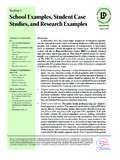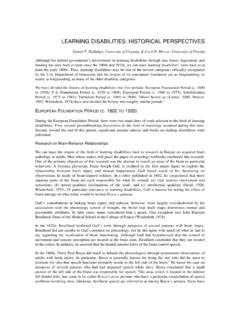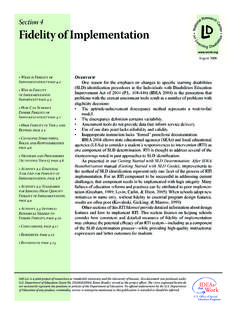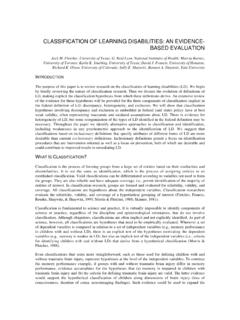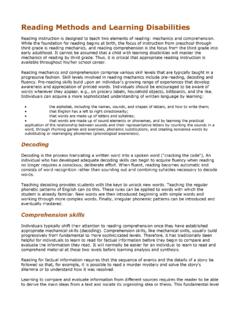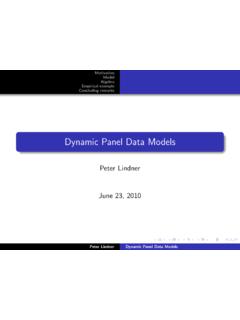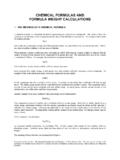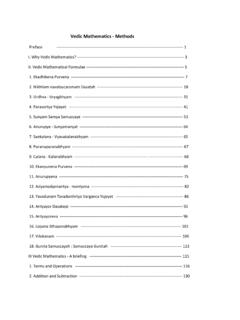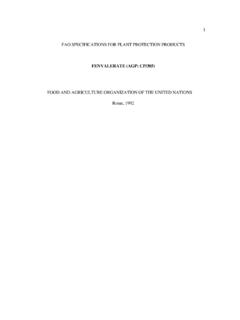Transcription of DISCREPANCY MODELS IN THE IDENTIFICATION …
1 DISCREPANCY MODELS IN THE IDENTIFICATION OF LEARNINGDISABILITYK enneth A. Kavale, University of IowaOn April 6, 1963, Samuel A. Kirk told a parent advocacy group that Recently, I have used the term learning disability to describe a group of children who have disorders in development, in language,speech, reading, and associated communication skills needed for social interaction (Kirk, 1975, p. 9). By1968, specific learning disability (LD) became a federally designated category of special education ( of Education, 1968). The formal definition offered at the time has not changed substantively andwas reaffirmed in the 1997 reauthorization of the Individuals With Disabilities Education Act [IDEA](Public Law 105-17) as follows:The term specific learning disability means a disorder in one or more of the basic psychologicalprocesses involved in understanding or in using language, spoken or written, which may manifestitself in imperfect ability to listen, think, speak, read, write, spell or do mathematical term includes such conditions as perceptual disabilities, brain injury, minimal braindysfunction, dyslexia, and developmental aphasia.
2 Such term does not include a learning problemthat is primarily the result of visual, hearing or motor disabilities, of mental retardation, ofemotional disturbance, or of environmental, cultural, or economic disadvantage (IDEAA mendments of 1997, PL105-17, 11 Stat. 37 [20 USC 1401(26)]). DISCREPANCY AND INTRA-INDIVIDUAL DIFFERENCESThe federal definition does not stipulate procedural guidelines for LD IDENTIFICATION . In fact, the definitionis primarily exclusive, describing what LD is not rather than identifying what LD is. Consequently,operational definitions necessary for practice have usually considered factors that may not have beenarticulated in the formal definition. One such factor that originated in the Kirk (1962) LD definition was thenotion of intra-individual differences, the possibility of subaverage functioning in only a few areas withaverage or above functioning in other areas.
3 Gallagher (1966) termed these developmental imbalances that were represented by discrepancies in psychoeducational functioning. One of the first suchdiscrepancies investigated was related to the cognitive abilities of students with LD. Using subtest scoresfrom cognitive assessments like the Wechsler Intelligence Scale for Children (WISC), patterns of strengthsand weaknesses were examined to determine whether the resulting scatter ( profile ) differentiated studentswith LD from other average or low achieving DISCREPANCIESThe clinical use of scatter-analysis methods has precipitated debate about its relationship to the nature ofLD ( , Miller, 1980; Wallbrown, Blaha, & Vance, 1980; Wallbrown, Vance, & Blaha, 1979). Forexample, hypotheses about uniqueness assume that the profile for samples of students with LD ischaracteristic of the entire LD population or that the LD subtest profile varies significantly from theaverage population.
4 The empirical evidence, however, has not supported any assumptions about LD profileuniqueness ( , Dudley-Marling, Kaufman, & Tarver, 1981; Gutkin, 1979; Kaufman, 1981).In a comprehensive quantitative synthesis, Kavale and Forness (1984) found no WISC profile for studentswith LD. For example, a DISCREPANCY between Verbal IQ and Performance IQ (VIQ-PIQ) has been assumedto be a primary LD characteristic. The difference (PIQ > VIQ) was, on average, only 3 IQ points, whichwas well below the requisite 11 IQ points necessary for significance. In addition, although studen ts withLD generally performed more poorly on Verbal subtests, no Verbal or Performance subtest score fell belowthe average level. Any measure of WISC inter-subtest variability ( scatter ) was not significant andindicated no subtest strength or weakness that distinguished LD the basis of hypotheses about cognitive performance, a number of different subtest score groupingshave been proposed to reveal discrepant abilities.
5 One method involves recategorizing subtest scoresexemplified in the proposal by Bannatyne (1968) that included a Spatial, Conceptual and Sequentialcategory, each based on three WISC subtests. An LD sample was presumed to show a Spatial > Conceptual> Sequential pattern, but, although exhibiting the required pattern, the magnitude of the score differenceswas well below required significance values. A second primary method was to seek a profile that eitherspecifies particular subtest scores as high or low or identifies subtests where students with LD might scorelow. For example, Ackerman, Peters, and Dykman (1971) studied the ACID profile (low scores on theArithmetic, Coding, Information, and Digit Span subtests) but, again, LD performance did not reach therequired level of significant suppression. Similarly, WISC factor scores ( , Naglieri, 1981) and WISC patterns ( , Myklebust, Bannochie, & Killen, 1971) have also been investigated, but in no instance wasdiscrepant LD performance at a level that could be termed longstanding criticism ( , Bijou, 1942) of examining discrepancies in cognitive performance toidentify LD appears justified.
6 In summarizing the available research, Kavale and Forness (1984) concludedthat Regardless of the manner in which WISC subtests were grouped and regrouped, no recategorization,profile, pattern, or factor cluster emerged as a clinically significant indicator of LD. In fact, whencompared to average levels, the LD group was found to exhibit no significant deviations, and on average,revealed less variability than normal populations (p. 150).ORIGINS OF ABILITY-ACHIEVEMENT DISCREPANCYThe failure to find significant cognitive (IQ) discrepancies in LD populations and the desire to reinforcenotions about the academic achievement deficits associated with LD directed attention to the possibility ofconceptualizing IQ-achievement discrepancies as a feature of LD. The IQ-achievement DISCREPANCY notionwas introduced by Bateman (1965) in a definition of LD that included the description of an educationallysignificant DISCREPANCY between estimated intellectual potential and actual level of performance related tobasic disorders in the learning processes (p.)
7 220).The idea of IQ-achievement DISCREPANCY was introduced by Franzen (1920) in the AccomplishmentQuotient (AQ). The AQ is the ratio of Educational Quotient (EQ) to Intelligence Quotient (IQ). Theimportance of IQ lies in its diagnosis of power of adaptation, and it has a high correlation with maximumpossible school progress (p. 434) while the EQ is the quotient resulting from the division of the age levelreached on the test in question by the chronological age of the pupil (p. 435). [T]he ratio of EQ to IQ [theAQ] gives the percentage of what that child could do, that he has actually done (p. 436).In cases where the AQ is less than 90, there is potential underachievement. A number of analysesappeared to show that, in general, AQs were typically less than unity ( ) ( , McPhail, 1922; Pintner &Marshall, 1921; Ruch, 1923). The resulting DISCREPANCY demonstrated by the laggards was oftenattributed to laziness ( , lack of effort) and if pupils are pushed to the extreme limit of their ability, thecorrelation between their educational achievement and their intelligence is not only high but actuallyreaches unity (Whipple, 1922, p.
8 600). In general, there was a belief that bright students were achievingless than expected, relative to ability, than were dull students whose lagging performance was presumedto indicate limited effort. Interestingly, with the 1920s view of intelligence as a fixed entity, IQ wasregarded as an index of the upper limit for academic attainment which meant AQs really could not exceedunity. As suggested by Franzen (1920), One s differences when EQ is subtracted from IQ are alwayspositive when they are large enough to be significant and small enough to seem spurious when they is safe, therefore, for practical use to assume that the optimum accomplishment is " ( ).In reality, findings surrounding the AQ were unreliable because of a number of psychometric and statisticalproblems. In a comprehensive analysis, Toops and Symonds (1922) discussed a number of flaws with theAQ that were a presage of many later analyses of ability-achievement DISCREPANCY .
9 Many other critiquesappeared; for example, J. C. Chapman (1923) pointed out the unreliability of using difference scores basedon intelligence and achievement test scores. W. R. Wilson (1928) suggested that Conclusions based on theuse of the accomplishment quotient are misleading unless they take into account the reliability of themeasures employed, the validity of the measures employed, and the part played by factors determining theintelligence quotient in school achievement under conditions of maximum maturation (p. 10).The major statistical criticism of AQ surrounded the operation of the regression effect (Crane, 1959;Cureton, 1937). The calculation of AQ assumed an almost perfect correlation between IQ and EQ, whereasthe value is closer to With less than perfect correlation between measures, scores well above averageon one measure will be less superior on the second measure, and at the other end of the continuum, thosescores well below average on the first measure will be less inferior on the second.
10 Consequently, if AQdoes not account for the effects of statistical regression, then there will be an overrepresentation of bright students and an underrepresentation of dull students. This result was demonstrated by Popenoe (1927)who found that Instead of each pupil having an equal chance to get a favorable accomplishment quotient,it appears that out of almost five hundred pupils, in no case did an individual having a high intelligencequotient get a favorable accomplishment quotient, and that individuals having a low intelligence quotientobtained accomplishment quotients far above the average. So an AQ of 100 means an entirely differentthing in a part of the range from what it does in another (p. 45). The many difficulties with AQ led to theconclusion that the administrative use of the accomplishment quotient is open to serious criticism (p. 47)and foreshadowed many later issues about the use of ability-achievement DISCREPANCY for LD AND LD IDENTIFICATION : RULES AND REGULATIONSThe Bateman (1965) notion of DISCREPANCY was not formally incorporated into the federal LD definition.
